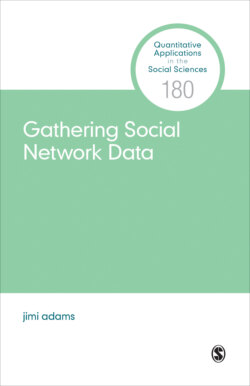Читать книгу Gathering Social Network Data - jimi adams - Страница 14
На сайте Литреса книга снята с продажи.
Two Broad Theoretical Frameworks
ОглавлениеIn an article focused on differentiating the benefits of particular local network positions for strategic performance within a market setting, Podolny Podolny (2001) introduced the terms pipes and prisms to label the two general theoretical means by which networks shape other outcomes. And I’ll expand this to show how these metaphors can equally be applied to questions addressing theories of networks. These terms offer tangible metaphors for the two most common underlying mechanisms at work within network research.
The pipes metaphor accounts for what is likely the most readily apparent network mechanism.10 Thinking of the ties within networks as pipes conveys the notion that networks provide potential pathways through which various “bits” can be passed from one node to another (Morris, 1993; Valente & Pitts, 2017). Those bits to be transmitted could be diseases spreading through contact networks, ideas flowing through communication networks, or money transfers across a financial market. In these cases, network studies aim to identify properties that promote or constrain the potential transmission of those bits through the population (Valente & Davis, 1999). For example, in the familiar kid’s game of “telephone,” the longer the distance that a message must travel, the less likely it is to be successfully transmitted (i.e., network distance reduces transmission likelihood). Or if more of the communication within a group must travel through a single party, the more likely that party is to have the ability to shape the opinions of the group (i.e., betweenness centrality increases control over flow through a population). Returning to Figure 1.1, from this perspective, we could explain why Node 6 would be more likely to successfully send something to Node 5 than to Node 1 and why Node 9 isn’t likely to receive anything from anyone else.
10 Other researchers have referred to this as a “connectionist” metaphor.
The prisms metaphor instead suggests that a node’s status can be gleaned from (reflected in) its position with respect to the pattern of relationships surrounding it (Wellman, 1988].11 In this orientation, networks shape patterns that reveal differences or similarities in roles between compared nodes. Research employing this metaphor aims to identify patterns of nodes’ locations within networks that meaningfully differentiate between their respective positions (Eguiluz, Zimmermann, San Miguel, & Cela-Conde, 2005).12 For example, while your aunt is not my aunt, our aunts are related to us in the same way—each is the sister of our respective parents (this is an example of structural equivalence). Or in organizational networks, administrative assistants often have higher levels of communication, because their relationships necessarily span levels within the hierarchy (connecting leaders to members of a single department) and often span across domains of the hierarchy (providing connections to administrative assistants in other departments, for example). These aunts or administrative assistants are not transmitting anything to one another but nevertheless still have similar behavioral expectations, revealed from their similar patterns of relationships.13 Drawing on this perspective, we might account for similarities between Nodes 2 and 7 in Figure 1.1 as deriving from each being similarly positioned on the periphery of the group.
11 This has occasionally been referred to as a “topological” metaphor for understanding networks. The original use of the term prisms by Podolny Podolny (2001) more narrowly described how relationships to particular others can reflect those alters’ status onto a specific ego. Here, I’m taking a slightly broader view in using this label to also include other relational determinants of social roles.
12 As is often the case in networks research, there are multiple levels at which these ideas can be applied. So, in addition to the application to nodes as noted in the text, we could also use the prismatic metaphor to compare between the structures of two or more networks, rather than focusing on positions within those networks.
13 Borgatti, Mehra, Brass, and Labianca (2009) further differentiate this perspective into adaptation and binding mechanisms, which differentially account for the way structural patterns around a focal (set of) node(s) can account for role expectations.
